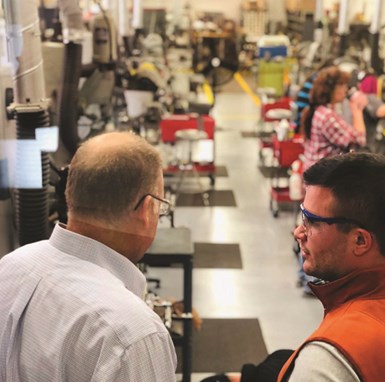COVID-19 Effects on the Manufacturing Workforce
How has COVID-19 actually affected the manufacturing workforce? Have employer needs changed? Are the changes here to stay?
#workforcedevelopment #pmpa

PMPA member Linas Biliunas, from Martindale Electric Co., discusses workforce needs with Taylor Evans.
Workforce is an evergreen issue for the manufacturing industry. With the changes in our COVID-19 world, some companies need more employees and some had to layoff employees. I talked to Taylor Evans from Rust Belt Recruiting to get his perspective.
I have to share how Taylor started his company. On the day Taylor and his wife found out they were pregnant with their second child, his wife told him to quit his job and start the recruiting company. Wow! Thereafter, Rust Belt Recruiting began serving the manufacturing industry by recruiting and placing temporary-to-hire and direct-hire employees.
As I am not familiar with the recruiting process, I asked Taylor how it worked. A temp-to-hire employee works for a company for 90 days, is on Rust Belt’s payroll, and is eligible for hire after the 90 days. This way the company can determine if the employee is a good fit before directly hiring them. Direct hire is what it sounds like — Rust Belt finds candidates and the company can hire them.
So how has COVID-19 actually affected the manufacturing workforce? Have employer needs changed? Are the changes here to stay? Taylor sees COVID-19 affecting the manufacturing workforce in several ways.
Short Term
From March to the writing of this article, the workforce has seen a dramatic change. Some shops are dependent on the automobile industry or other industries that slowed and had to lay off employees. There are several shops that supply the medical field, were awarded ventilator part jobs or make other virus essential parts and they are actively hiring.
Featured Content
Long Term
Eventually, the economy will get back to some semblance of “normal” and the people in other industries (such as retail, restaurants, or hospitality) who were furloughed or laid off may see manufacturing in a different light. Manufacturing kept going while other industries came to a standstill. Manufacturing is essential and it is everywhere. The world needs manufacturing to survive. According to Taylor, “There may be a renaissance of sorts where people view manufacturing jobs as stable and desirable.”
Additionally, in about six to 18 months, we could see a change in the supply chain and more reshoring. These changes would bring a lot of work back and the manufacturers are going to need additional employees.
Silver Lining
Many of us look for the silver lining when things look bad. When I asked Taylor what he thought the COVID-19 silver lining is with regard to the manufacturing workforce he boiled it down to three outcomes:
- A greater appreciation for the importance of manufacturing
- A resurgence in the manufacturing work in our country
- An awareness that spans all age groups about the viability and the security that can come with a manufacturing job — unlike in other industries.
As Taylor summed it up, “Those three outcomes could be really exciting and I hope that high school guidance counselors and school leaders begin to encourage their students to consider a manufacturing career path.”
About the Author
Carli Kistler-Miller, MBA, has over 20 years of experience with communications, event/meeting planning, marketing, writing and operations. Email cmiller@pmpa.org.
RELATED CONTENT
-
Succession Planning: Three 15-Minute Activities to Start Preparing for Tomorrow
Succession planning is planning for the future success of your business.
-
New Line of Swiss-Types for Job Shops Eyeing High-Production Work
Mazak now offers the Syncrex line of Swiss-type CNC lathes — its first — targeting machine shops getting into higher volume production of complex parts.
-
Determine Passivation of Stainless
Properly cleaned stainless steel is naturally protected from corrosion by a thin, passive film. But this passive layer can be removed or scratched. A passivation meter measures the surface potential under controlled conditions.






